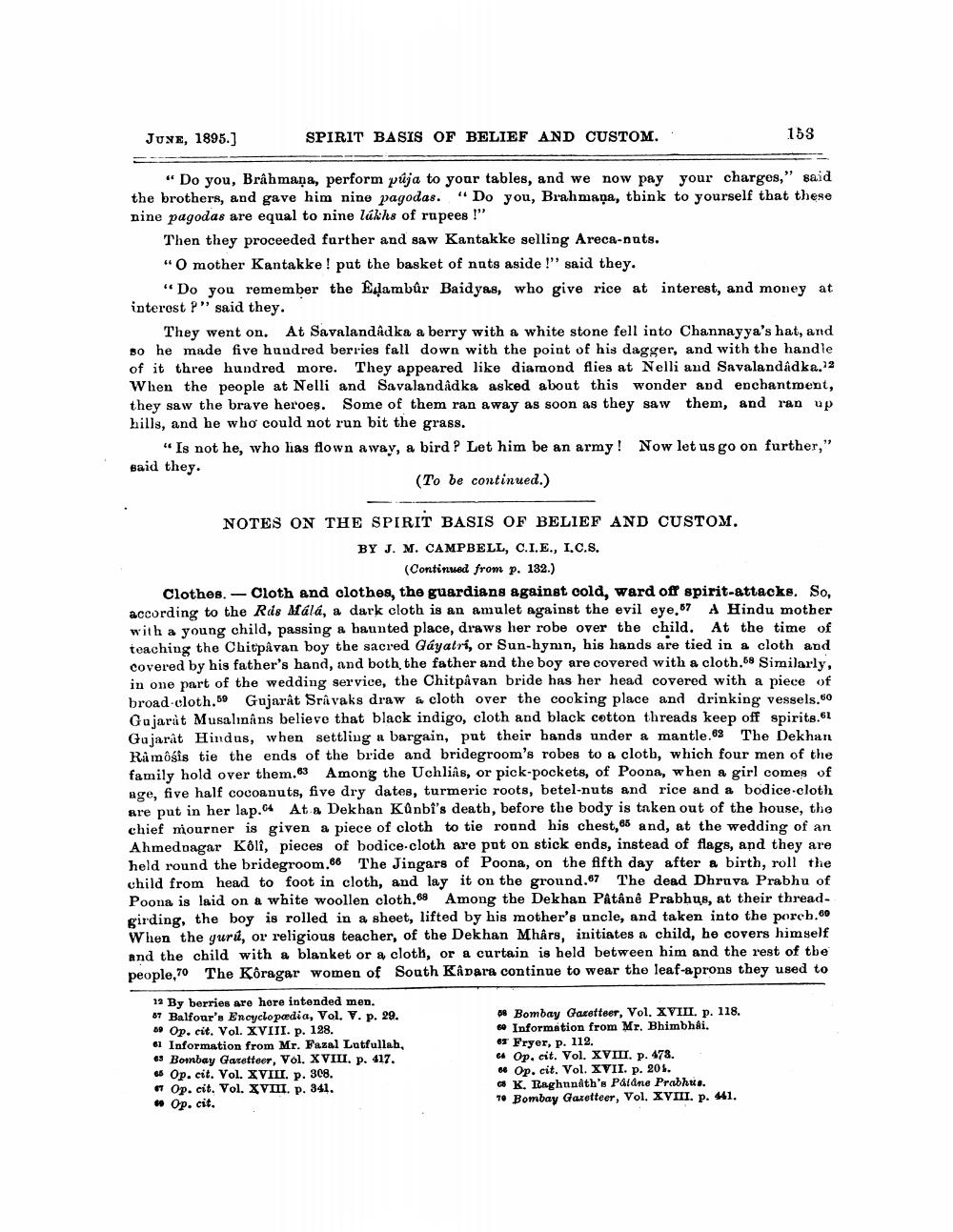________________
SPIRIT BASIS OF BELIEF AND CUSTOM.
JUNE, 1895.]
"Do you, Brahmana, perform púja to your tables, and we now pay your charges," said the brothers, and gave him nine pagodas. " Do you, Brahmana, think to yourself that these nine pagodas are equal to nine lakhs of rupees !"
Then they proceeded further and saw Kantakke selling Areca-nuts.
"O mother Kantakke! put the basket of nuts aside!" said they.
"Do you remember the Edambûr Baidyas, who give rice at interest, and money at interest ?" said they.
They went on. At Savalandâdka a berry with a white stone fell into Channayya's hat, and so he made five hundred berries fall down with the point of his dagger, and with the handle of it three hundred more. They appeared like diamond flies at Nelli and Savalandâdka,12 When the people at Nelli and Savalandâdka asked about this wonder and enchantment, they saw the brave heroes. Some of them ran away as soon as they saw them, and ran up hills, and he who could not run bit the grass.
"Is not he, who lias flown away, a bird? Let him be an army! Now let us go on further," said they.
(To be continued.)
NOTES ON THE SPIRIT BASIS OF BELIEF AND CUSTOM.
BY J. M. CAMPBELL, C.I.E., I.C.S.
(Continued from p. 132.)
Clothes. Cloth and clothes, the guardians against cold, ward off spirit-attacks. So, according to the Rás Málá, a dark cloth is an amulet against the evil eye,57 A Hindu mother with a young child, passing a haunted place, draws her robe over the child. At the time of teaching the Chitpâvan boy the sacred Gayatri, or Sun-hymn, his hands are tied in a cloth and covered by his father's hand, and both, the father and the boy are covered with a cloth.58 Similarly, in one part of the wedding service, the Chitpâvan bride has her head covered with a piece of broad cloth.50 Gujarat Sravaks draw & cloth over the cooking place and drinking vessels.60 Gujarat Musalmâns believe that black indigo, cloth and black cotton threads keep off spirits.61 Gujarat Hindus, when settling a bargain, put their hands under a mantle.62 The Dekhan Ramôgis tie the ends of the bride and bridegroom's robes to a cloth, which four men of the family hold over them.63 Among the Uchliâs, or pick-pockets, of Poona, when a girl comes of age, five half cocoanuts, five dry dates, turmeric roots, betel-nuts and rice and a bodice-cloth are put in her lap. At a Dekhan Künbi's death, before the body is taken out of the house, the chief mourner is given a piece of cloth to tie round his chest,65 and, at the wedding of an Ahmednagar Kôli, pieces of bodice-cloth are put on stick ends, instead of flags, and they are held round the bridegroom.66 The Jingars of Poona, on the fifth day after a birth, roll the child from head to foot in cloth, and lay it on the ground.67 The dead Dhruva Prabhu of Poona is laid on a white woollen cloth.68 Among the Dekhan Pâtânê Prabhus, at their threadgirding, the boy is rolled in a sheet, lifted by his mother's uncle, and taken into the porch.00 When the gurú, or religious teacher, of the Dekhan Mhârs, initiates a child, he covers himself and the child with a blanket or a cloth, or a curtain is held between him and the rest of the people,70 The Kôragar women of South Kâpara continue to wear the leaf-aprons they used to
12 By berries are here intended men. 57 Balfour's Encyclopædia, Vol. V. p. 29. 59 Op. cit. Vol. XVIII. p. 128.
61 Information from Mr. Fazal Lutfullah,
63 Bombay Gazetteer, Vol. XVIII. p. 417.
65 Op. cit. Vol. XVIII. p. 308.
Op. cit. Vol. XVIII. p. 341.
"Op. cit.
153
58 Bombay Gazetteer, Vol. XVIII. p. 118.
60 Information from Mr. Bhimbhai.
er Fryer, p. 112.
64 Op. cit. Vol. XVIII. p. 478.
ee Op. cit. Vol. XVII. p. 201.
cs K. Raghunath's Pâtâne Prabhus.
70 Bombay Gazetteer, Vol. XVIII. p. 441.




